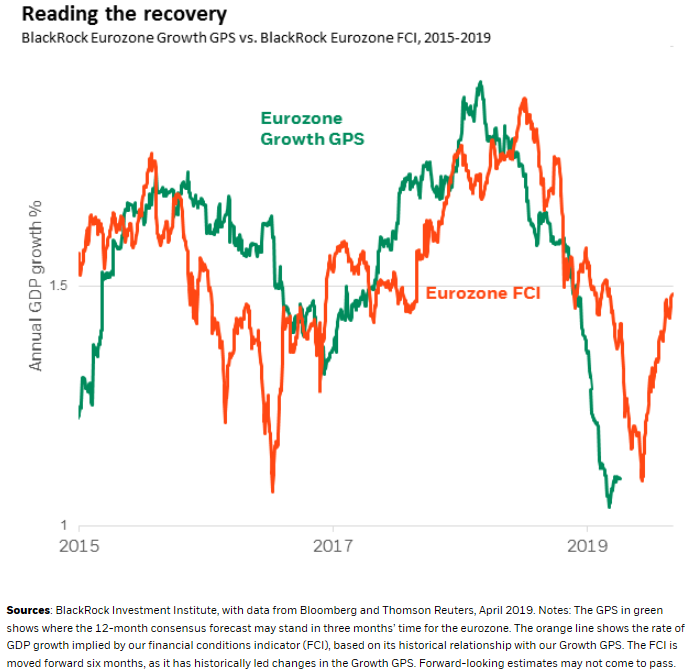by Elga Bartsch, PhD, Blackrock
Elga explains the reasons we see a European economic recovery in the second half of the year – including an easing of financial conditions, Chinese stimulus and solid domestic demand.
Europe is still holding back global growth, having been a key support in prior years. Yet much of the eurozone weakness can be attributed to the fading support from export demand as world trade nosedived. As the most open G3 economy, Europe suffered more greatly.
In the coming months, we expect Europe to gradually move out of its tricky spot, as we write in our Macro and market perspectives A renewed spring in Europe’s step. This view assumes that the UK’s dragged-out Brexit debate doesn’t morph into a disruptive exit and rising US-EU trade tensions don’t shock confidence.
The U.S. slapping tariffs on European products–whether autos or other–should have only a moderate direct economic impact. Unless it sparks a broader confidence shock, this shouldn’t disrupt the solid domestic economic picture. And so we expect the upbeat domestic trend to reassert itself once global trade starts to normalize and idiosyncratic setbacks–such as auto production–and sector bottlenecks fade.
Euro-zone growth is supported by accommodative monetary policy, a more expansionary fiscal policy stance, higher than normal capacity utilization rates and labor markets approaching full employment. Our financial conditions indicator (FCI) shows that euro-zone conditions have eased significantly in the first part of 2019 – an improvement that is on par with the one seen in early 2016. For that reason, we expect GDP growth to pick up and move slightly above trend levels (around 1.25%) in the second half of this year.
What underpins our call for a recovery?
A rebound in the FCI, Chinese stimulus and fading headwinds. Half of the nearly 80 euro-zone activity indicators, summarized in our euro-zone Growth GPS nowcast, are starting to show meaningful improvement.
Industrial data for the start of the year are still poor. Germany–where factory orders plunged in February–remains the weakest link. But other data–especially for the services sector–are holding up or starting to recover. And incoming information on near-term growth tentatively suggests building momentum at the start of the second quarter. Our euro-zone Growth GPS started to stabilize in mid-March, indicating that the consensus forecasts for euro-zone GDP over the next 12 months are close to bottoming out. See the Reading the recovery chart.
The GDP forecast downgrades that began at the start of 2018 may have nearly run their course. Historically, our GPS signal has led consensus forecasts by about three months (see our interactive macro dashboard for more detail). This suggests that investors still have some time to position themselves for potential forecast upgrades.
Elga Bartsch, PhD, Head of Economic and Markets Research for the BlackRock Investment Institute, is a regular contributor to The Blog.
Investing involves risks, including possible loss of principal.
Fixed income risks include interest-rate and credit risk. Typically, when interest rates rise, there is a corresponding decline in bond values. Credit risk refers to the possibility that the bond issuer will not be able to make principal and interest payments. Non-investment-grade debt securities (high-yield/junk bonds) may be subject to greater market fluctuations, risk of default or loss of income and principal than higher-rated securities.
International investing involves special risks including, but not limited to currency fluctuations, illiquidity and volatility. These risks may be heightened for investments in emerging markets.
This material is not intended to be relied upon as a forecast, research or investment advice, and is not a recommendation, offer or solicitation to buy or sell any securities or to adopt any investment strategy. The opinions expressed are as of April 2019 and may change as subsequent conditions vary. The information and opinions contained in this post are derived from proprietary and nonproprietary sources deemed by BlackRock to be reliable, are not necessarily all-inclusive and are not guaranteed as to accuracy. As such, no warranty of accuracy or reliability is given and no responsibility arising in any other way for errors and omissions (including responsibility to any person by reason of negligence) is accepted by BlackRock, its officers, employees or agents. This post may contain “forward-looking” information that is not purely historical in nature. Such information may include, among other things, projections and forecasts. There is no guarantee that any forecasts made will come to pass. Reliance upon information in this post is at the sole discretion of the reader. Past performance is no guarantee of future results. Index performance is shown for illustrative purposes only. You cannot invest directly in an index.
©2019 BlackRock, Inc. All rights reserved. BLACKROCK is a registered trademark of BlackRock, Inc., or its subsidiaries in the United States and elsewhere. All other marks are the property of their respective owners.
BIIM0519U-836462-1/1














